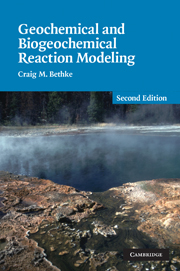Book contents
- Frontmatter
- Contents
- Preface
- Preface to first edition
- A note about software
- 1 Introduction
- 2 Modeling overview
- Part I Equilibrium in natural waters
- Part II Reaction processes
- Part III Applied reaction modeling
- 22 Hydrothermal fluids
- 23 Geothermometry
- 24 Evaporation
- 25 Sediment diagenesis
- 26 Kinetics of water–rock interaction
- 27 Weathering
- 28 Oxidation and reduction
- 29 Waste injection wells
- 30 Petroleum reservoirs
- 31 Acid drainage
- 32 Contamination and remediation
- 33 Microbial communities
- Appendix 1 Sources of modeling software
- Appendix 2 Evaluating the HMW activity model
- Appendix 3 Minerals in the LLNL database
- Appendix 4 Nonlinear rate laws
- References
- Index
32 - Contamination and remediation
Published online by Cambridge University Press: 05 August 2012
- Frontmatter
- Contents
- Preface
- Preface to first edition
- A note about software
- 1 Introduction
- 2 Modeling overview
- Part I Equilibrium in natural waters
- Part II Reaction processes
- Part III Applied reaction modeling
- 22 Hydrothermal fluids
- 23 Geothermometry
- 24 Evaporation
- 25 Sediment diagenesis
- 26 Kinetics of water–rock interaction
- 27 Weathering
- 28 Oxidation and reduction
- 29 Waste injection wells
- 30 Petroleum reservoirs
- 31 Acid drainage
- 32 Contamination and remediation
- 33 Microbial communities
- Appendix 1 Sources of modeling software
- Appendix 2 Evaluating the HMW activity model
- Appendix 3 Minerals in the LLNL database
- Appendix 4 Nonlinear rate laws
- References
- Index
Summary
Groundwater remediation is the often expensive process of restoring an aquifer after it has been contaminated, or at least limiting the ability of contaminants there to spread. In this chapter, we consider the widespread problem of the contamination of groundwater flows with heavy metals. We use reactive transport modeling to look at the reactions that occur as contaminated water enters a pristine aquifer, and those accompanying remediation efforts.
The method or methods employed to remediate an aquifer vary, depending on the type, degree, and extent of contamination. Where pollution is shallow and dispersed over a small area, the sediments can sometimes be dug up and transported to a landfill designed especially to isolate the contaminants. Permeable reaction barriers can be installed to intercept a contaminant plume and strip pollutants from it, if the plume is shallow and narrowly focused.
Metal contaminants can in some cases be immobilized in situ by oxidation or reduction, or precipitated by reaction with sulfide. Sulfate reducing bacteria are sometimes stimulated to produce sulfide, or a sulfur-bearing compound such as calcium polysulfide can be injected into the subsurface as a reductant and sulfide source. In certain cases where the contamination poses little immediate threat, it can safely be left to attenuate naturally (e.g., Brady et al., 1998), a procedure known as monitored natural attenuation.
Remediation more commonly proceeds by a pump-and-treat scheme in which contaminated water is drawn from the aquifer and treated at the surface to remove contaminant metals, before being discharged or reinjected into the aquifer.
- Type
- Chapter
- Information
- Geochemical and Biogeochemical Reaction Modeling , pp. 461 - 470Publisher: Cambridge University PressPrint publication year: 2007



